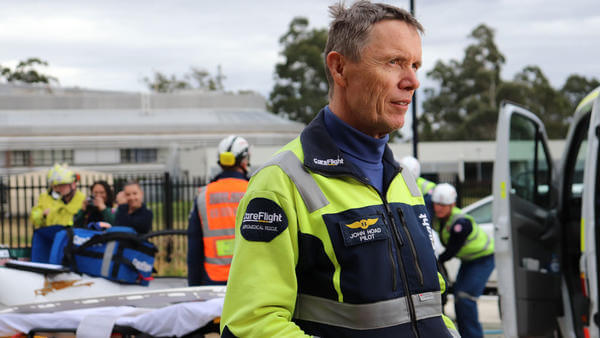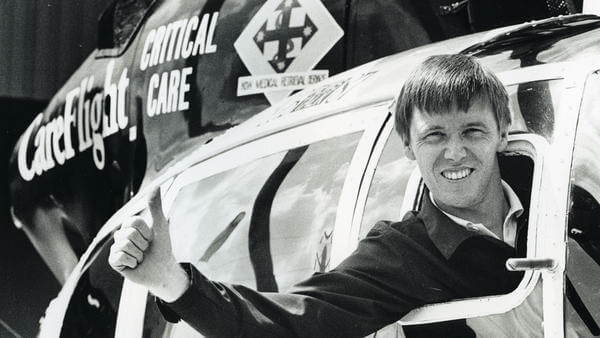Interview: John Hoad, Co-Founder of CareFlight

Jackie Annett spoke to Co-Founder of CareFlight, John Hoad, about his 35-year career as a pilot and the special skills needed to be a HEM pilot in Australia
Tell us how you became a pilot?
After finishing school, I applied to join the Australian Defence Force as a trainee pilot but I wasn’t successful, so I had to choose a different career path. I became a radiographer but even though I enjoyed my job, my dream of flying never disappeared. An opportunity to go for a helicopter ride came up and the first moment that the helicopter lifted off the ground, my dreams came flooding back – I realized I had to pursue them.
What challenges did you face?
The first hurdle was how I was going to finance my dream as training to become a commercial pilot is expensive. I decided to sell my house and gave up my job as a radiographer which drew strong criticism from work colleagues and family, but I knew I had to take a leap of faith.
Once I’d got my license it was then extremely difficult to get a job. Inexperienced pilots mean higher insurance costs for employers. So, I headed to the outback where I worked for two years herding cattle! It’s not unusual to use helicopters for herding cattle in Australia and, in my first year, I flew over 1,000 hours in a Bell 47.
After that, I worked in Papua New Guinea doing sling load work. This work fine-tuned my skills at precision hovering, which was excellent preparation for my next job with Westpac Rescue. Not long after that, I helped found CareFlight and this is where I’ve been for the last 35 years.
Why did you feel there was a market for a new company?
I left Westpac Rescue to start CareFlight with a team who believed we could provide an integrated service comprising of people across all disciplines. Having worked in hospitals, I have a thorough understanding of how they operate and I could see that by integrating aviation and medicine, we could achieve something much greater than what was on offer at the time.
It was an extraordinary effort which probably wouldn’t be possible today. We identified the key elements needed to get the service up and running and allocated the best people to make it happen. The team’s commitment to establishing CareFlight was phenomenal: we went from nothing to being fully operational in four months.
Looking at where CareFlight is now compared to its humble beginnings, what are you most proud of?
When we established CareFlight, we were determined that safety would be an integral part of our culture so I’m most proud of the fact that we’ve maintained a very strong safety culture over the 35 years we’ve been in business.
At a personal level, I’m really proud of what we have given back to the community. When we save a life or improve a patient’s outcome, they often write to us or come and visit. It’s lovely to experience the difference that we’ve made to their lives and their families.
What’s inspired you to invest in the H145 helicopter?
We started out by asking the senior aviation working group what the ideal helicopter would be for the rapid response operation. The H145 was on top of that list. For us to be the most effective in our roles, we needed to have the best helicopter for the job and the team is extremely happy with the outcome.
What’s the biggest challenge facing HEMS operators in Australia right now?
The biggest challenge has got to be that there is no direct training pathway for pilots. The current pool isn’t getting any younger and it’s becoming increasingly difficult to recruit pilots with all the necessary skills and experience.
Because we fly single pilot, pilots coming into the job need to have specialized experience as a captain, so the pool of potential candidates is small. Recruiting for these jobs is already proving difficult and it’s only going to get worse.
How much has technology reduced pilots’ workload?
The Helionix avionics system in the H145 is an integrated modular system which makes a significant difference to pilots flying this aircraft. The test protocols are integrated so the pilot doesn’t have to spend a lot of time in pre and after start checks. The system is ideal for a rapid response operation where minutes can make the difference between life and death.
The flight envelope protection makes sure you don’t fly outside the flight limitations of the aircraft, while the power protection ensures the pilot doesn’t exceed the limitations of the engine. The H145 will even automatically engage the fourth axis to reduce the rate of descent as air speed decreases to avoid getting into a vortex ring.
What qualities are needed to become a HEMS pilot?
First and foremost, you need to be the kind of person who can work effectively in a team. Team members are dependent on each other to get the mission completed successfully. Secondly, you need to be able to put safety ahead of emotion, for everyone’s benefit including the patient.
In a rapid response role, you don’t know what you’re going to be doing until the phone rings, so you need to be organized and not the type of person who stresses easily.

July 2021
Issue
- Adapting skills and aircraft for police multi-mission capabilities
- How UAVs can boost force efficiency
- Selecting the right equipment for police surveillance and SAR
- Interdisciplinary HEMS crew integration in Norway
- An exclusive excerpt from PostFlight: An Old Pilot’s Logbook
- Interviews: Tab Burnett, Alaska Department of Public Safety; Kevin Kissner, Virginia State Police
- Provider Profile: European Air Ambulance
Jackie Annett
Jackie is a staff writer for AirMed&Rescue.










